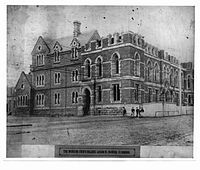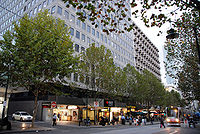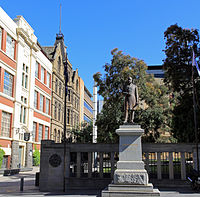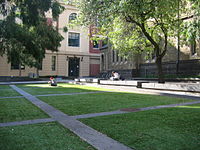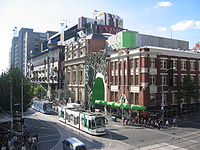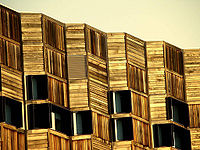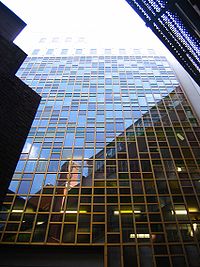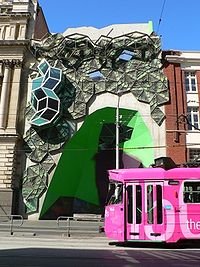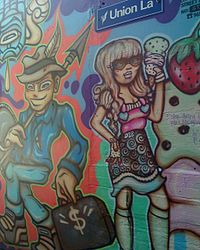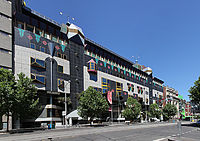- RMIT University
-
RMIT University 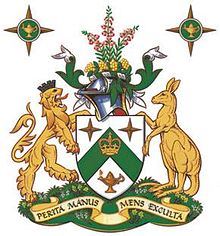
Latin: Universitas Technicus Melburnensis Regia Motto perita manus mens exculta (Latin) Motto in English "a skilled hand, a cultivated mind" (Non-literal translation) Established 1887[1] Type Public Endowment A$1.107b (2007)[2] Chancellor Dr. Ziggy Switkowski Vice-Chancellor Prof. Margaret Gardner, AO Academic staff 3,604 (2008)[3] Students 49,476 (2008) (inc. TAFE) Undergraduates 33,603 (2008) Postgraduates 10,371 (2008) Location Melbourne, Victoria, Australia
37°48′28″S 144°57′48″E / 37.80778°S 144.96333°ECoordinates: 37°48′28″S 144°57′48″E / 37.80778°S 144.96333°ECampus Urban Former names The Working Men's College
(1887–1933)
Melbourne Technical College
(1934–1959)Sports mascot RMIT Redbacks Colours Red, Black, White
Affiliations ASAIHL, ATN, GU8, OUA Website rmit.edu.au 
RMIT University (officially the Royal Melbourne Institute of Technology) is an Australian public university located in Melbourne, Victoria. It has two branches, referred to as RMIT University in Australia and RMIT International University in Vietnam.
RMIT was founded in 1887 by prominent grazier and philanthropist, The Hon. Francis Ormond. It is the third-oldest higher education provider in the state of Victoria and the seventh-oldest in Australia. Its foundation campus "RMIT City" is located at the northern end of the Melbourne CBD. RMIT was awarded royal patronage in 1954, and is the only Australian university to have received the honour.[4]
According to the THES - QS World University Rankings in 2009, RMIT is ranked in the top 10 universities in Australia. It is included in the top 100 universities in the World for producing work-ready graduates, and is one of 20 institutes of technology that feature in the listing. It has an internationally recognised reputation for advertising[5], art, communication, design, engineering and technology.
RMIT pioneered the dual sector education system in Australia during the mid-20th century.[6] It is now the largest institution of its type in the country, and offers every level of award available in the Australian Qualifications Framework.[7] Academically, the university focuses on higher education and research while its TAFE division focuses on vocational education and training.
It is a founding member of the Australian Technology Network and the Global U8 Consortium.
Contents
History
Main article: History of the Royal Melbourne Institute of TechnologyEarly history
The Working Men's College of Melbourne was founded in 1887 by a prominent grazier and philanthropist, The Hon. Francis Ormond MLC, who donated £5000 toward the establishment of the college.[6][8] The Council of the Melbourne Trades Hall then matched Ormond's initial donation through rallying its members.[6][8] On 4 June, the college opened in a purpose-built building on the corners of Bowen Street and La Trobe Street in Melbourne, with a gala ceremony,[6][8] becoming the third official provider of higher education in the Colony of Victoria (the Melbourne Athenaeum was founded in 1839 and the University of Melbourne in 1853). In 1904, the college was incorporated under the Companies Act as a private institution.[6][8]
Between the turn of the 20th century and 1930s, the college expanded dramatically over the former Melbourne Gaol site with the establishment of an art school, an engineering school and a radio school. In 1934, it then changed its name to the Melbourne Technical College.[6][8] During the 1940s, over the course of World War II, it trained a sixth of Australia’s service personnel (mainly Royal Australian Air Force radio communication officers), 2000 civilians in munitions manufacturing and was commissioned by the Government of Australia to manufacture parts for aircraft, including most parts for the Beaufort Bomber.[6][8] In 1954, it was awarded royal patronage by Queen Elizabeth II for its service to the war effort – becoming the only Australian university to receive the honour – and it was renamed the Royal Melbourne Technical College.[6][8]
Creation of RMIT
In 1960, the college changed its name to the Royal Melbourne Institute of Technology (RMIT) and began to reconstitute itself as a tertiary institution.[6][8] The college was incorporated into the institute as a vocational school (TAFE) and, during the 1970s and 1980s, the institute developed a reputation in art and aeronautical engineering.[6][8] In 1979, it amalgamated with the neighbouring exclusive women’s Emily McPherson College of Domestic Economy, which brought with it a reputation in fashion design and food technology.[6][8] In 1992, it was granted public university status by the Government of Victoria under the Royal Melbourne Institute of Technology Act, and adopted the name RMIT University for its tertiary arm and RMIT TAFE for its vocational arm.[8][9]
During the 1990s, the university underwent a rapid expansion and amalgamated a number of neighbouring institutes.[8] In 1995, it developed a “country campus” in Bundoora and acquired the heritage-listed Former Melbourne Magistrates' Court.[8] In 1999, it developed a “design campus” in Brunswick and acquired the heritage-listed Capitol Theatre.[8] During this time, it also developed a reputation in eco-friendly design. At the turn of the 21st century, it was invited by the Government of Vietnam to develop the country's first foreign owned university.[8] It opened its first campus in Ho Chi Minh City in 2001, and a second campus in Hanoi in 2004.
Rankings
The former Times Higher Education Supplement and Quacquarelli Symonds (THES-QS) partnership placed RMIT 55th in 2004 World University Rankings. Consecutively since then, they have also placed RMIT as one of the top 100 universities in the World that produces work-ready graduates.
In 2009, they ranked RMIT as the fourth most internationalised university in the World - behind the University of London's School of Economics and School of Oriental and African Studies and Cranfield University, according to students, and 15th in the World according to faculty/staff.[10][11]
RMIT is also ranked as the top entrepreneurial university in Australia, and 12th in the World, according to the GSEA annual Top Entrepreneurial Universities List.[12] It is ranked as the top advertising school of the decade in Australia and 5th in the World, according the YoungGuns International Awards.[13] In Victoria, RMIT is currently ranked as the 4th most research-intensive university, and 19th in Australia.[citation needed]
In November of 2011 RMIT was recognised by the Australian Skeptics with a Bent Spoon Award for their teaching of ‘Energy Medicine’, Chiropractic and Chinese Medicine, all of which lack scientific rigour. The price was awarded during the national convention of the Australien Skeptics in Sydney.
Organisation
The Royal Melbourne Institute of Technology is a public university created under the Royal Melbourne Institute of Technology Act of 1992 by the Government of Victoria.[9] It has two main branches known as RMIT University (encompassing RMIT TAFE) and RMIT International University - both of which are registered trading names.[14] Before its creation as a public university, RMIT was a private institution for 105 years.[6]
It is structured as 25 semi-autonomous schools, offering over 700 programs at vocational (TAFE), undergraduate, postgraduate and research levels.[15][16] Each school is grouped into one of three academically-contextual colleges, which are known as "Business", "Design and Social Context" and "Science, Engineering and Health".[17] Most schools also maintain their own field-relevant research collections, which are in addition to the RMIT University Library network (see: Notable school collections). RMIT's 30+ centres of excellence are also grouped into a college according to their context, to allow for cross-field research.
Colleges and Schools
College of Business
- RMIT School of Accounting and Law
- RMIT School of Business IT and Logistics
- RMIT TAFE School of Business
- RMIT School of Economics, Finance and Marketing
- RMIT Graduate School of Business and Law
- RMIT School of Management
College of Design and Social Context
- RMIT School of Architecture and Design
- RMIT School of Art
- RMIT TAFE School of Design
- RMIT School of Education
- RMIT School of Fashion and Textiles
- RMIT School of Global Studies, Social Science and Planning
- RMIT School of Media and Communication
- RMIT School of Property, Construction and Project Management
College of Science, Engineering and Health
- RMIT School of Aerospace, Mechanical and Manufacturing Engineering
- RMIT School of Applied Sciences
- RMIT School of Civil, Environmental and Chemical Engineering
- RMIT School of Computer Science and Information Technology
- RMIT School of Electrical and Computer Engineering
- RMIT TAFE School of Engineering
- RMIT School of Health Sciences
- RMIT School of Life and Physical Sciences
- RMIT School of Mathematical and Geospatial Sciences
- RMIT School of Medical Sciences
Not grouped into a College
- RMIT School of Graduate Research
Council and Chancellery
The greater RMIT is governed by a council of 22 members, known as the "RMIT Council".[18] The Governor-in-Council is the RMIT Chancellor, Ziggy Switkowski. The Council is responsible for the "direction and superintendence" of RMIT University, and the administration of RMIT International University Holdings Pty. Ltd. – a wholly owned subsidiary of RMIT. Day-to-day operations of the greater RMIT are managed by the RMIT Vice-Chancellor, Professor Margaret Gardner, AO - who is also the President of RMIT University in Australia. The President of RMIT International University in Vietnam is Professor Merilyn Liddell, AM.
Key people
- Ziggy Switkowski – Chancellor of RMIT, Governor of RMIT Council
- Professor Margaret Gardner, AO – Vice-Chancellor of RMIT, President of RMIT University
- Professor Merilyn Liddell, AM – Pro Vice-Chancellor of RMIT, President of RMIT International University
- Steve Somogyi – Vice-President and Chief Operating Officer of RMIT
- Professor Gill Palmer – Pro Vice-Chancellor of the College of Business
- Professor Colin Fudge – Pro Vice-Chancellor of the College of Design and Social Context
- Professor Peter Coloe – Pro Vice-Chancellor of the College of Science, Engineering and Health
- Professor Diane Alcorn – Pro Vice-Chancellor of Research and Innovation
- Professor Joyce Kirk – Pro Vice-Chancellor of Students
- Allan Ballagh – Director of RMIT TAFE
Research
RMIT has over 30 research institutes and centres, either based within its colleges and schools or operating autonomously within the university, and a large number of research clusters and groups. It is ranked as one of Australia’s top 10 research universities;[19] and focuses on applied research, outcome-related research and consultancy services – which area all in line with its industry-relevant ethos. It also has extensive partnerships and collaborations with government and industry.[20]
Its four top-ranked international research institutes include: RMIT Design Research Institute, RMIT Global Cities Research Institute, RMIT Platform Technologies Research Institute and RMIT Health Innovations Research Institute.[21] A number of top independent research institutes are also based at RMIT, including the Australian Housing and Urban Research Institute and the Australian branch of the US' Nautilus Institute for Security and Sustainability.[22][23]
Notable research centres include: Australian Centre for Human Rights Education, RMIT Centre for Animation and Interactive Media, RMIT Centre for Design, RMIT Globalism Centre, International Centre for Environment and Bio Ethics, International Centre for Graphic Design, International Centre for Housing and Urban Research, Sir Lawrence Wackett Aerospace Centre and RMIT Spatial Information Architecture Laboratory.[24]
Major collaborative partners with RMIT include: Asia-Pacific Economic Cooperation in the Australian APEC Study Centre,[25] Australian Institute of Sport as its preferred partner in sports technology research, Boeing Company in a systems development centre called the Boeing-RMIT Phantom Works,[26] Government of Australia in Cooperative Research Centres and Government of Victoria in a design industry advancement centre called DesignVictoria.[27][28] RMIT is also partnered with Fujitsu, as well as Victoria's two other top-ranked universities - the University of Melbourne and Monash University, in Australia's first low carbon emission and energy-efficient technology data centre.[29][30][31]
Many organisations are also permanently partnered with RMIT's institutes, centres and schools for research. Notable partners include: Airbus, Australian Defence Force, BHP Billiton, BMW AG, Country Road, CSIRO, Deloitte, Ernst&Young, Ford Motor Company, GUESS, GM Holden, IBM, Luxottica, Pacific Brands, Siemens, Subaru, Telstra, Tenix, United Nations and Volkswagen Group.[32][33][34][35][36][37][38][39]
Campuses
RMIT University maintains three campuses in Victoria, Australia - City, Bundoora and Brunswick. It also operates a number of specialised "sites" - in metropolitan Melbourne and in rural Victoria. RMIT International University maintains two campuses in Vietnam - Ho Chi Minh City and Hanoi. RMIT offers distance/online education through Open Universities Australia and is partnered with over 190 educational institutions around the World. In 2003, over 58,000 students studied at RMIT. Currently, prospective students of RMIT have a choice of more than 700 higher education and TAFE programs located across all campuses, sites, by distance/online education and with partner institutions.[15]
Australia
RMIT City
Main article: RMIT CityThe City campus is RMIT's original and flagship campus. It was established in 1887, as the "Working Men's College of Melbourne", in a single building on the corner of La Trobe and Bowen streets. It's currently the largest of RMIT's campuses, in both Australia and Vietnam, and occupies nearly four city blocks at the northern end of the Melbourne CBD; which is often referred to as the "RMIT Quarter" of the city.
It is the only university campus entirely located within the Melbourne CBD and spans an area loosely bordered to the north by Queensberry Street, the east by Lygon and Russell streets, the south by La Trobe Street and the west by Elizabeth Street.[40] It is divided into four precincts referred to as: the "Art Precinct", "Carlton Precinct", "Justice Precinct" and "Swanston Precinct". Some buildings are also not located on the campus, which include: the entire College of Business, located on nearby Bourke Street, and the Capitol Theatre on southern Swanston Street.
The City campus is notable for its mix of modern and contemporary architecture as well as Victorian and gothic revival architecture.[41] As of 2007, the campus is also undergoing a A$500 million redevelopment in accordance with RMIT's "2007 - 2010 Infrastructure Plan".[42]
RMIT City offers programs university-wide.[43]
RMIT Bundoora
Established in 1995, RMIT Bundoora is the award-winning "country campus" of RMIT.[44] It is RMIT's second oldest and second largest campus and is located in Bundoora, 20 km from the City campus. RMIT Bundoora is divided into two campuses by Plenty Road, known as East and West. The older West campus was the former site of the Phillip Institute of Technology, which amalgamated with RMIT in 1992.[8] The campuses have their own transport interchange which is served by a dedicated tram route (86/RMIT Bundoora-Docklands) and dedicated bus route (570/RMIT Bundoora-Thomastown). The nearest train station to RMIT Bundoora is Thomastown station.
Unlike the urban RMIT City campus in Melbourne, the West campus is set in 42 ha of parklands and designed to be eco-friendly and sustainable. RMIT has sought to preserve much of the natural heritage of both campuses, notably the "Keelbundoora Scarred Tree Trail" - a rare collection of 800+-year-old red gum trees (lat: Eucalyptus tereticornis), located within the grounds of the West campus, with historical markings by Indigenous Australians.[45][46]
The smaller East campus has a specific focus on engineering, and is home to the RMIT Renewable Energy Park, RMIT Wind Tunnel testing facility and the RMIT Racing teams. The larger West campus has a general focus on sciences, and is home to RMIT's biosciences buildings and the Bundoora Netball and Sports Centre, an environmentally sustainable sport centre and facilities.[47][48] The West campus consists mainly of contemporary architecture and many of its buildings have gone on to win national awards for architectural and sustainable design.[44]
RMIT Bundoora offers programs in aerospace engineering, electrical engineering, mechanical engineering, medical sciences and social sciences.[49]
RMIT Brunswick
The Brunswick campus is RMIT's specialised design campus,[50] and is located 5 km from the City campus, in Brunswick. Situated on Dawson Street, the campus is near Sydney Road, one of outer Melbourne's most multicultural shopping strips and the site of many restaurants, pubs and markets, as well as large art and music festivals.[51] The campus is well serviced by train via the close by Jewell station and by a number of trams that travel along Sydney Road.
Established in 1999, it is RMIT's smallest and youngest campus, although the history of RMIT Brunswick can be dated back over 50 years prior to the former Melbourne Institute of Textiles - which amalgamated with RMIT in 1998, and originally occupied the site of the campus.[52] RMIT Brunswick is home to the International Centre for Graphic Technology, RMIT Printing Centre and RMIT Textile Centre, and the campus is a combination of industrial and contemporary architecture.[50]
RMIT Brunswick offers programs in fashion design, graphic design, printing, publishing and textiles.[53]
Other sites
Royal Dental Hospital, Melbourne
RMIT operates levels 3 and 4 of the Royal Dental Hospital of Melbourne - a collaboration between Dental Health Services Victoria, RMIT and the University of Melbourne.[54][55] The RMIT component consists of a primary care clinic, specialist services unit, day surgery theatres and the emergency clinic.[56]Fishermen's Bend, Port Melbourne
The Fishermen's Bend aerospace district, in Port Melbourne, is the site of RMIT's award-winning Sir Lawrence Wackett Aerospace Centre. It was established in 1991, and moved to new facilities at its current site in 2007.[57][58]RAAF Base Williams, Point Cook
The Royal Australian Air Force base "Williams" at Point Cook is the site of RMIT's Flight Training Facility.[59] The base is the World's oldest operational military airfield and birthpace of Australia's air force.[60] RMIT has shared a historical association with the Royal Australian Air Force, which dates back to World War II.RMIT Hamilton, Southern Grampians
Hamilton is the site of RMIT's Regional Education and Community Development Centre and is known as "RMIT Hamilton" for short. It was established in 2000 and conducts research into rural development, and partners with local farmers and businesses to assist with the development of Victoria's western region.[61] RMIT Hamilton also grants degrees in rural nursing and education, to assist with dire regional requirements.[62]Bullock Island, Lakes Entrance
Bullock Island is the site of RMIT's Marine Research and Education Centre and the RMIT Aquaculture Research Facility, and is located near Lakes Entrance. It was established in 2004, and is contiguous with the South-East Australia Maritime Centre.[63] RMIT has provided training in Victoria's eastern region since 1994 (through its partner institutions), and continues to assist with the development of the region.[64]International
RMIT Vietnam
RMIT International University in Vietnam, also known as "RMIT Vietnam" for short, was established in Ho Chi Minh City in 2001.[65] It is Vietnam's first fully foreign-owned university and RMIT's second major international venture (a Malaysian site known as "RMIT Penang" operated between 1996 and 1999). In 2004, a second campus was established in the Vietnamese capital city of Hanoi. Currently, RMIT Vietnam campuses have a combined population of over 5,000 students from Vietnam, Australia as well as various other countries. RMIT Vietnam's degrees are recognised by the Vietnamese Ministry of Education and Training and are awarded by RMIT University in Australia.[65]
Collections and galleries
RMIT University Library
Main article: RMIT University LibraryRMIT University Library is the central library network at RMIT.[66] It has six locations across RMIT's Australian campuses, each reflecting the academic focus of their respective campuses. The Swanston Library at the RMIT City campus is the university's largest library,[66] and is considered to be one of the top five libraries in Melbourne.[67] As a library of the Australian Technology Network,[66] RMIT University Library invests substantially in electronic resources and in online and A/V collections.[66] It also has access to over 400 global databases containing over a hundred thousand e-journals, reports, conference papers, e-books, etc.[66]
RMIT Research Repository
The Library also manages the RMIT Research Repository - an online databank containing a number of electronic records and full texts of peer-reviewed published articles and conference papers, books and chapters; as well as other forms of research, produced by RMIT staff. Access to the Repository is available free of charge to anyone in the World, not just to RMIT staff and students.[68] The Repository was launched to the public in 2009. Records are harvested by Google, OAIster and Australian Research Online (formerly the Arrow Discovery Service).Notable school collections
AFI Research Collection
Main article: RMIT School of Media and Communication#AFI Research CollectionThe AFI Research Collection is a specialist, non-lending film and television resource; opened in the mid-1970s by the Australian Film Institute (AFI) and Victorian Federation of Film Societies.[69] It also contains the valuable David Francis Collection and the notable Henry Mayer and the Wayne Royal Levy collections and became an auspice of the RMIT School of Media and Communication in 2002.[69]
Architecture and Art
RMIT holds considerable architecture and Australian art collections. Many of its campuses' buildings are a part of its architecture collection, along with substantial archives held by the RMIT School of Architecture and Design. RMIT's Australian art collection is maintained by RMIT Gallery in Storey Hall (also part of its architecture collection). The Australian art collection also includes the valuable W.E. Macmillan Collection (gold and silver) and notable Lindsay Edward Collection (fine art).The history of the collection is documented in the book: "A Skilled Hand and Cultivated Mind".[70][71]
Design
The RMIT Design Archives is held by the RMIT School of Architecture and Design.[72] It contains substantial costume, couture, fashion illustration and textile collections, and includes: the Prue Acton, Alfredo Bouret, Frances Burke, Louis Kahan, Hall Ludlow, Robert Maltus and Bee Taplin collections.[72]National Aerospace Resource Centre
The National Aerospace Resource Centre collection is an initiative of the RMIT School of Aerospace, Mechanical and Manufacturing Engineering and the Royal Aeronautical Society. It consists of approximately 100,000 volumes, including: technical reports (from NASA, NACA, AMRL, DSTO, and other aerospace organisations), conference proceedings, books, videos, aircraft manuals and journals.[73]Art galleries and spaces
RMIT is considered to be one of the most reputable art and design universities in Australia,[74][75][76] which is reflected in its ten permanent art galleries. Nine are located on the RMIT City campus and one at the RMIT Bundoora-West campus.
The university's largest gallery is RMIT Gallery, which is housed in the historic original section of Storey Hall at the City campus. RMIT Gallery is open to the public free of charge, and is considered to be one of Melbourne’s best contemporary art galleries.[77]
Other galleries are operated within schools of RMIT, and include the Design Hub Gallery,[78] Field 36 Gallery,[79] The DrawingSpace (a Metasenta Gallery),[80] RMIT Virtual Reality Centre and Gallery,[81][82] Viscom Gallery,[83] and the RMIT School of Art Gallery and Project Space Gallery.[84] The RMIT Union also operates two galleries which are the First Site Gallery and PitSpace Gallery (the latter at the RMIT Bundoora-West campus).
RMIT also has a number of temporary art spaces throughout the city of Melbourne, and conducts regular exhibitions in public spaces.[85]
RMIT Gallery also curates the Fracture Gallery located in the atrium of Federation Square.[86][87]
Campus and student life
See also: List of clubs and societies of the Royal Melbourne Institute of TechnologyMost activities, clubs and organisations for RMIT students are managed by either the RMIT Union or the RMIT Student Union (RUSU). The two unions differ in that RMIT Union is an unincorporated subsidiary body owned by the university that's concerned with campus life and administers a wide range of arts, sporting and recreational activities and collectives for students.[88] Whereas RMIT Student Union is an independent, not-for-profit and student-run organisation that's concerned with student life, and administers clubs and services in support of students.[89] A number of other activities and clubs are also run independently of RMIT's unions, usually within a school of the university.
RMIT Union
Main article: RMIT UnionThe purpose of the RMIT Union is to contribute positively and enhance the RMIT community by providing valuable learning, development and social opportinities in a co-curricular setting.[88] Its divided into branches, known as: Arts and Sports & Recreation, which administer a range of arts, sports and recreation activities and collectives.
Arts
- Projector Obscura - time-based exhibitions collective
- Prolog Writers Collective - creative writing and play/screenwriting development and support collective
- RMIT Music - the collective representing all of RMIT's music groups, including the RMIT Symphonic Orchestra (RSO)
- RMIT Performing Arts - the general performing arts collective, including "RMIT Idol" (singing) and theatre performance
- Stream - audio art and visual art exhibitions collective
- Theatre in Bars - original theatre production collective
Sports & Recreation
Sports
- Community sports clubs - see: List of clubs and societies of the Royal Melbourne Institute of Technology
- RMIT Redbacks - RMIT's sporting collective consisting of a wide variety of sports teams.
Recreation
- City Fitness - RMIT's main fitness centre located in Building 8, RMIT City; open to staff, students and the general public.
- Preston Alpine Ski Lodge - RMIT's ski lodge located at Mount Buller Village; available for hire by staff and students only.
RMIT Student Union
The RMIT Student Union operates as a not-for-profit organisation and is run entirely by students. It's responsible for RMIT's student media organisations, campus events, student support collectives and welfare groups as-well-as student administered academic and national-based general interest clubs and societies.[89]
Departments
- Activities - the department responsible for student activities and events
- Clubs and Societies - see: List of clubs and societies of the Royal Melbourne Institute of Technology
- Campaigns Collective - campaigns for education and welfare issues and run in collaboration with the various departments
- Organarchy - a student-run cooperative social enterprise which specialises in the retail of natural and ethical organic food
- RMIT Environment Collective - students advocating environmental responsibility and sustainability within RMIT campuses
- RMIT International Students Collective - supports and advocates the rights of international students
- RMIT Postgraduate Students Association (RPA) - the representative body of postgraduate students
- RMIT Queer Collective - supports and advocates the rights of RMIT's LGBT community
- RMIT Womyn's Collective - supports and advocates the rights of women
- Welfare and Education - the department responsible for issues relating to student welfare and academic program support
Media organisations
Publication
- Catalyst - the RMIT student magazine, distributed free every month of the academic year, since 1944
- Ex Calamus - an RMIT literary magazine, distributed both online and in print in various locations around Melbourne.
Radio
- 3RRR - founded by RMIT in 1976,[90] now funded mainly by subscription but still utilised by the university
- SYN Radio - RMIT's current student radio station, which was founded in 2001 and broadcasts on 90.7FM[91]
- ABC Radio - relayed RMIT radio programming on: 3LO 774, 3RN 621, 3ABC-FM 105.9, 3JJJ-FM 107.5, 3PB 1026; and digital radio on: DiG Radio, ABC Jazz and ABC Country.[92]
Television
- RMITV - RMIT's student television production house, broadcasting since 1987, and co-founder of C31[93]
- SYN TV - the television production division of SYN's activities, in partnership with RMITV and C31
- C31 Melbourne - Melbourne community television station, which was co-founded by RMITV in 1994[94]
- ABC Melbourne - RMIT produced programming is also relayed on ABC state and national television[92]
Non-union clubs/societies
- RMIT Golden Key - the RMIT chapter of the Golden Key International Honour Society
- RMIT LEAD - student leadership development through volunteer community programs
- RMIT MET - major events managed by marketing students, independent of the unions
- RMIT Racing - RMIT's Formula SAE engineering and racing team, which is considered to be one of the best in the world
- RMIT SEEDS - student entrepreneurship, education, development in society scheme
RMIT Spiritual Centre
Main article: RMIT Spiritual CentreThe RMIT Spiritual Centre is a historical building located on the City campus of RMIT. The centre provides a space for worship to all staff and students of RMIT, regardless of their faith and without showing favour to any one faith, and houses the RMIT Chaplaincy service.[95]
Graduates
Main article: List of Royal Melbourne Institute of Technology peopleRMIT has an internationally recognised reputation for architecture, art, communication, design, engineering and technology; and its industry-relevant ethos.[76][96][97][98][99] It has produced notable graduates in: Art, Business (with strength in Commerce), Communication studies (with strength in Media studies), Design (with strengths in Architecture, Communication Design, Fashion Design and Industrial Design; specifically sustainable design), Engineering (with strengths in Aerospace and Mechanical engineering), Health Sciences (with strengths in Bioscience and Traditional medicine), Social Sciences and Technology (with strengths in Information Technology and Nanotechnology).
Graduation parade
See also: Academic dress of the Royal Melbourne Institute of TechnologyA notable graduation tradition of RMIT is its annual graduation parade - a town and gown-style academic procession along the major Melbourne thoroughfare of Swanston Street. The parade members march one kilometre in full academic dress from Bowen Street (in the RMIT City campus), down Swanston Street, and culminate at Federation Square (until 2002, the parade culminated outside the Melbourne Town Hall).[100] The parade receives a military escort from the central marching band of the Royal Australian Air Force, of which RMIT shares a historical association with, and graduands are accompanied by staff and alumni.
The parade is welcomed at Federation Square by the Lord Mayor of Melbourne, on behalf of the city and its citizens. The Lord Mayor then grants RMIT's Vice-Chancellor a "writ of passage" to proceed with the graduation ceremony, which takes place at the Docklands Stadium, and is the largest university graduation ceremony in Australia.[101][102]
References
- ^ About RMIT - Heritage
- ^ RMIT 2007 Annual Report
- ^ RMIT Strategic Plan Update
- ^ Rmit History
- ^ [1]
- ^ a b c d e f g h i j k l Murray-Smith & Dare 1987
- ^ About RMIT (RMIT homepage)
- ^ a b c d e f g h i j k l m n o p A Timeline of RMIT history (RMIT Homepage)
- ^ a b Royal Melbourne Institute of Technology Act of 1992
- ^ THES - QS Top Universities - International Students
- ^ THES - QS Top Universities - International Faculty
- ^ Global Student Entrepreneur Awards release second annual Top Entrepreneurial Universities List - PR Inside, 19 October 2009
- ^ RMIT named top advertising school in Australia. MarketingMag.com.au. Retrieved 28 October 2010.
- ^ About RMIT - About our name
- ^ a b RMIT 2008 Course Guide
- ^ Academic Schools at RMIT (RMIT Homepage)
- ^ RMIT Update No. 12/2009 - Change to SET College name to SEH
- ^ RMIT University Secretariat - Council Members
- ^ THES - QS Top Universities - Australia and New Zealand
- ^ RMIT University Research homepage
- ^ RMIT University – Research Institutes
- ^ RMIT University - Australian Housing and Urban Research Institute
- ^ Nautilis Institute homepage
- ^ RMIT University – Research Centres
- ^ RMIT University – Australian APEC Study Centre
- ^ Boeing launches Australian research centre – Openline (RMIT News), 10 August 2008
- ^ RMIT University – Collaborative Research Centres
- ^ DesignVictoria homepage
- ^ Universities launch green data centre - Openline (RMIT News), 9 October 2009
- ^ Vic Unis share Green Data Centre - CeBit Australia, 13 October 2009
- ^ Victorian universities team for green data centre - ITWire, 7 October 2009
- ^ Industry and Business - Advanced Technologies (RMIT Homepage)
- ^ Industry and Business - Aerospace and Aviation (RMIT Homepage)
- ^ Industry and Business - Automotive (RMIT Homepage)
- ^ Industry and Business - Built environment and Infrastructure (RMIT Homepage)
- ^ Industry and Business - Fashion and Textiles (RMIT Homepage)
- ^ Industry and Business - Financial Services (RMIT Homepage)
- ^ Luxottica sees the big picture with RMIT - Openline (RMIT News), 3 October 2008
- ^ RMIT named UN-Habitat Partner University - Openline (RMIT News), 5 December 2008
- ^ RMIT City campus map (RMIT Homepage)
- ^ RMIT's historic buildings (RMIT Homepage)
- ^ RMIT University Infrastructure Plan - Property Component 2007 - 2010
- ^ Programs offered at the City campus (RMIT Homepage)
- ^ a b Bundoora campus (RMIT Homepage)
- ^ Management plan to save historic trees - Openline (RMIT News), 1 July 1997
- ^ Sharing our heritage through 800-year-old trees - Openline (RMIT News), 6 June 2008
- ^ New 'green sports centre' in RMIT Bundoora opens - Openline (RMIT News), 25 February 2002
- ^ Bundoora Netball and Sports Centre
- ^ Programs offered at the Bundoora campus (RMIT Homepage)
- ^ a b Brunswick campus (RMIT Homepage)
- ^ Sydney Road, Brunswick
- ^ RMIT affiliation with Melbourne Institute of Textiles - Openline (RMIT News), 24 October 1998
- ^ Programs offered at the Brunswick campus (RMIT Homepage)
- ^ Dental Health Services Victoria homepage
- ^ RMIT a proud partner in new $52m dental hospital - Openline (RMIT News), 29 July 2003
- ^ RMIT Property Services - Royal Dental Clinic of Melbourne
- ^ Sir Laurence Wackett Aeropace Centre (RMIT Homepage)
- ^ Boost for Melbourne aerospace industry - Openline (RMIT News), 5 November 2007
- ^ Point Cook (RMIT Homepage)
- ^ RAAF Base Williams (Royal Australian Air Force)
- ^ History of RMIT Hamilton (RMIT Homepage)
- ^ RMIT Hamilton (RMIT Homepage)
- ^ Marine centre opens on Bullock Island - Openline (RMIT News), 28 July 2004
- ^ RMIT and East Gippsland (RMIT Homepage)
- ^ a b About RMIT Vietman (RMIT Vietnam Homepage)
- ^ a b c d e RMIT University Library (RMIT Homepage)
- ^ M magazine article - The Age, 27 July 2008
- ^ RMIT Research Repository
- ^ a b RMIT AFI Research Collection (RMIT School of Applied Communicaion)
- ^ Edquist & Grierson 2008
- ^ Treasures in the heart of the city - Openline (RMIT News), 29 February 2008
- ^ a b Fashion and Textiles collections (RMIT School of Architecture and Design)
- ^ National Aerospace Resource Centre at RMIT (RMIT University Library)
- ^ Australian Government - Department of Education Employment and Workplace Relations
- ^ Art Education - RMIT School of Art
- ^ a b RMIT University - Fashion Institute of Technology profile
- ^ About RMIT Gallery (RMIT Gallery)
- ^ Spatial Information Architecture Laboratory resources (RMIT University)
- ^ Field 36 Gallery (RMIT School of Media and Communication),
- ^ Global Art/MetaSenta (RMIT School of Art)
- ^ RMIT Virtual Reality Centre and Gallery,
- ^ Melbourne, where virtual reality is a virtue - The Age, 17 May 2003
- ^ Viscom 9 Gallery (RMIT School of Media and Communication)
- ^ RMIT School of Art galleries (RMIT School of Art)
- ^ RMIT School of Art - Art in Public Spaces discipline
- ^ RMIT Gallery - Fracture Gallery
- ^ Federation Square - Fracture Gallery
- ^ a b About Us (Launch: RMIT Union homepage)
- ^ a b About (RMIT Student Union website)
- ^ About 3RRR, Triple R 102.7
- ^ About SYN (Student Youth Network Homepage)
- ^ a b ABC Local Radio (ABC Local Homepage)
- ^ About RMITV (RMITV Homepage)
- ^ C31 Homepage
- ^ RMIT Chaplaincy - RMIT Spiritual Centre
- ^ RMIT University - StudyLink profile
- ^ RMIT University - Study in Australia profile
- ^ RMIT University - Education.com profile
- ^ Reputation - About RMIT Architecture (RMIT School of Architecture and Design)
- ^ Graduation Parade (RMIT Homepage)
- ^ Hats off to the class of 2007 - Openline (RMIT News) 14 December 2007
- ^ Class of ’07 makes big impact - Openline (RMIT News) 21 December 2007
Texts:
Murray-Smith, Stephen; Dare, Anthony J. (1987), The Tech: A Centenary History of the Royal Melbourne Institute of Technology (1st ed.), South Yarra (Melbourne): Hyland House, ISBN 0947062068
Edquist, Harriet; Grierson, Elizabeth (2008), A Skilled Hand and Cultivated Mind: A Guide to the Architecture and Art of RMIT, Melbourne: RMIT University Press, ISBN 9781921166914
Royal Melbourne Institute of Technology (RMIT) Branches and Campuses RMIT University (City · Bundoora · Brunswick · Other sites) · RMIT International University (Saigon South · Hanoi)
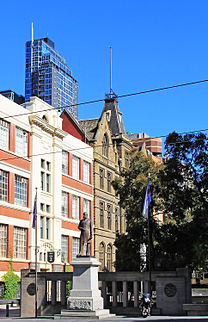
Buildings of Significance Capitol Theatre · Emily McPherson College · Magistrates' Court · Spiritual Centre · Storey Hall · Working Men's College
Colleges and Schools College of Business
Accounting and Law · Business IT and Logistics · TAFE Business · Economics, Finance and Marketing · Graduate Business and Law · Management
College of Design and Social Context
Architecture and Design · Art · TAFE Design · Education · Fashion and Textiles · Global Studies, Social Science and Planning · Media and Communication · Property, Construction and Project Management
College of Science, Engineering and Health
Aerospace, Mechanical and Manufacturing Engineering · Applied Sciences · Civil, Environmental and Chemical Engineering · Computer Science and Information Technology · Electrical and Computer Engineering · TAFE Engineering · Health Sciences · Life and Physical Sciences · Mathematical and Geospatial Sciences · Medical Sciences
Not in a College
Graduate ResearchStudent Organisations (List) Catalyst · RMIT Music · RMIT Racing · RMIT Redbacks · RMIT Student Union · RMIT Union · RMITV · SYN
History, People, etc. History · Alumni · Academic dress · Libraries · Francis Ormond · Ziggy Switkowski · Margaret Gardner
 Universities in Australia
Universities in AustraliaAustralian Capital Territory Australian Defence Force Academy (UNSW accredited degrees) · Australian National University · University of Canberra
New South Wales Northern Territory Queensland South Australia University of Adelaide · University of South Australia · Flinders University · Heinz College, Australia · UCL, Australia
Tasmania Victoria University of Ballarat · Deakin University · La Trobe University · University of Melbourne · Monash University · Royal Melbourne Institute of Technology · Swinburne University of Technology · Victoria University
Western Australia National Universities in Victoria, Australia University of Ballarat · BRIT · Box Hill Institute · Cental Gippsland Institute · Chisholm Institute · East Gippsland Institute · Gordon Institute · Goulburn Ovens Institute · Holmesglen Institute · Kangan Institute · NMIT · RMIT · Sunraysia Institute · South West Institute · Swinburne University of Technology · Victoria University · William Angliss Institute · Wodonga InstituteGlobal U8 Consortium Haifa • Hull • INHA • Le Havre • Rhode Island • RMIT • Washington • Xiamen
Australian Technology Network Curtin • QUT • RMIT • South Australia • UTS
Open Universities Australia Partner Universities Secondary Providers University of Adelaide • Australian Catholic University • Charles Darwin University • La Trobe University • Learning Network of Queensland • Murdoch University • TAFESA • University of New England • TAFEWA
Categories:- RMIT University
- Universities in Victoria (Australia)
- TAFE Victoria
- Global U8 Consortium
- Australian Technology Network
- Open Universities Australia
- Landmarks in Melbourne
- Technical universities and colleges
- Association of Commonwealth Universities
- Universities in Australia
- Universities in Vietnam
- Universities in Melbourne
- Universities in Ho Chi Minh City
- Australian vocational education and training providers
- TAFE Colleges in Melbourne
- Distance education institutions
- Online colleges
- Educational institutions established in 1887
- Organisations based in Australia with royal patronage
- 1887 establishments in Australia
Wikimedia Foundation. 2010.

